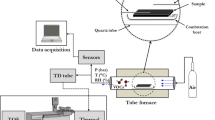Abstract
A thermogravimetric analyzer and a Fourier-transform infrared (FTIR) spectrometer were combined and redesigned for investigations with corrosive and condensable reactive gases. The standard gas inlet and outlet of the thermogravimetric analyzer were changed in order to heat the gas tubes, which are lead through the flanges, and avoid condensation in these parts of the system. Furthermore, all tubes upstream and downstream of the thermogravimetric analyzer were trace heated up to 180 °C. The gas measuring cell of the FTIR spectrometer was designed such that an optimum compromise between the small flow rates through the thermogravimetric analyzer and a short residence time of the gases in the gas measuring cell could be achieved. The gas supply allows the dosage of different gas compositions containing nitrogen, oxygen, water, NH3, and NO2, for example. The system was validated by analyzing the composition of a diesel particulate matter (PM) sample with a temperature-programmed desorption followed by oxidation (TPD/O) experiment, which showed good agreement with the established analysis methods. The reactivity of the PM sample was investigated by temperature-programmed oxidation (TPO) experiments with different reactive gas mixtures of oxygen, water, and NO2 in nitrogen. By adding NO2, the soot oxidation started at lower temperatures and the addition of water lead to a shift of the maxima of the carbon oxidation rates to lower temperatures. The ratio of formed CO2 and CO was shifted to higher values by the addition of NO2 and water whereby the influence of water was much more pronounced.









Similar content being viewed by others
References
Madarász J, Kaneko S, Okuya M, Pokol G. Comparative evolved gas analyses of crystalline and amorphous titanium(IV)oxo-hydroxo-acetylacetonates by TG-FTIR and TG/DTA-MS. Thermochim Acta. 2009;489(1–2):37–44.
Madarász J, Varga PP, Pokol G. Evolved gas analyses (TG/DTA-MS and TG-FTIR) on dehydration and pyrolysis of magnesium nitrate hexahydrate in air and nitrogen. J Anal Appl Pyrol. 2007;79(1–2):475–8.
Qu H, Wu W, Wu H, Xie J, Xu J. Study on the effects of flame retardants on the thermal decomposition of wood by TG-MS. J Therm Anal Calorim. 2010. doi:10.1007/s10973-010-1103-3.
Wyrzykowski D, Hebanowska E, Nowak-Wiczk G, Makowski M, Chmurzyński L. Thermal behaviour of citric acid and isomeric aconitic acids. J Therm Anal Calorim. 2010. doi:10.1007/s10973-010-1015-2.
Etienne S, Becker C, Ruch D, Germain A, Calberg C. Synergetic effect of poly(vinyl butyral) and calcium carbonate on thermal stability of poly(vinyl chloride) nanocomposites investigated by TG-FTIR-MS. J Therm Anal Calorim. 2010;100(2):667–77.
Mocanu A, Odochian L, Apostolescu N, Moldoveanu C. Comparative study on thermal degradation of some new diazoaminoderivatives under air and nitrogen atmospheres. J Therm Anal Calorim. 2010;100:615–22.
Plante AF, Fernández JM, Leifeld J. Application of thermal analysis techniques in soil science. Geoderma. 2009;153(1–2):1–10.
Souza B, Moreira A, Teixeira A. TG-FTIR coupling to monitor the pyrolysis products from agricultural residues. J Therm Anal Calorim. 2009;97(2):637–42.
Tao L, Zhao G-B, Qian J, Qin Y-k. TG-FTIR characterization of pyrolysis of waste mixtures of paint and tar slag. J Hazard Mater. 2010;175(1–3):754–61.
Xu T, Huang X. A TG-FTIR investigation into smoke suppression mechanism of magnesium hydroxide in asphalt combustion process. J Anal Appl Pyrol. 2010;87(2):217–23.
Setiabudi A, Makkee M, Moulijn JA. The role of NO2 and O2 in the accelerated combustion of soot in diesel exhaust gases. Appl Catal B. 2004;50(3):185–94.
Muckenhuber H, Grothe H. The heterogeneous reaction between soot and NO2 at elevated temperature. Carbon. 2006;44(3):546–59.
Muckenhuber H, Grothe H. A drifts study of the heterogeneous reaction of NO2 with carbonaceous materials at elevated temperature. Carbon. 2007;45(2):321–9.
Jeguirim M, Tschamber V, Brilhac JF, Ehrburger P. Interaction mechanism of NO2 with carbon black: effect of surface oxygen complexes. J Anal Appl Pyrol. 2004;72(1):171–81.
Jeguirim M, Tschamber V, Brilhac JF, Ehrburger P. Oxidation mechanism of carbon black by NO2: effect of water vapour. Fuel. 2005;84(14–15):1949–56.
Matsui K, Tsuji H, Makino A. Estimation of the relative rates of the C–O2 and the C–H2O reactions. Carbon. 1983;21(3):320–1.
Ahlström AF, Odenbrand CUI. Combustion characteristics of soot deposits from diesel engines. Carbon. 1989;27(3):475–83.
Neeft JPA, Nijhuis TX, Smakman E, Makkee M, Moulijn JA. Kinetics of the oxidation of diesel soot. Fuel. 1997;76(12):1129–36.
Jacquot F, Logie V, Brilhac JF, Gilot P. Kinetics of the oxidation of carbon black by NO2: influence of the presence of water and oxygen. Carbon. 2002;40(3):335–43.
Kong Y, Cha CY. NOx adsorption on char in presence of oxygen and moisture. Carbon. 1996;34(8):1027–33.
Richter E, Kleinschmidt R, Pilarczyk E, Knoblauch K, Jüntgen H. Thermal desorption of nitrogen oxides from activated carbon. Thermochim Acta. 1985;85:315–8.
Messerer A, Niessner R, Poschl U. Comprehensive kinetic characterization of the oxidation and gasification of model and real diesel soot by nitrogen oxides and oxygen under engine exhaust conditions: measurement, Langmuir-Hinshelwood, and Arrhenius parameters. Carbon. 2006;44(2):307–24.
Acknowledgements
We acknowledge U. Jörimann and M. Schubnell from Mettler-Toledo as well as A. Möps, H. Belz, and D. Hohler from Thermo Fisher Scientific for technical help and support.
Author information
Authors and Affiliations
Corresponding author
Additional information
10th European Symposium on Thermal Analysis and Calorimetry.
Rights and permissions
About this article
Cite this article
Mehring, M., Elsener, M. & Kröcher, O. Development of a TG-FTIR system for investigations with condensable and corrosive gases. J Therm Anal Calorim 105, 545–552 (2011). https://doi.org/10.1007/s10973-010-1178-x
Published:
Issue Date:
DOI: https://doi.org/10.1007/s10973-010-1178-x




